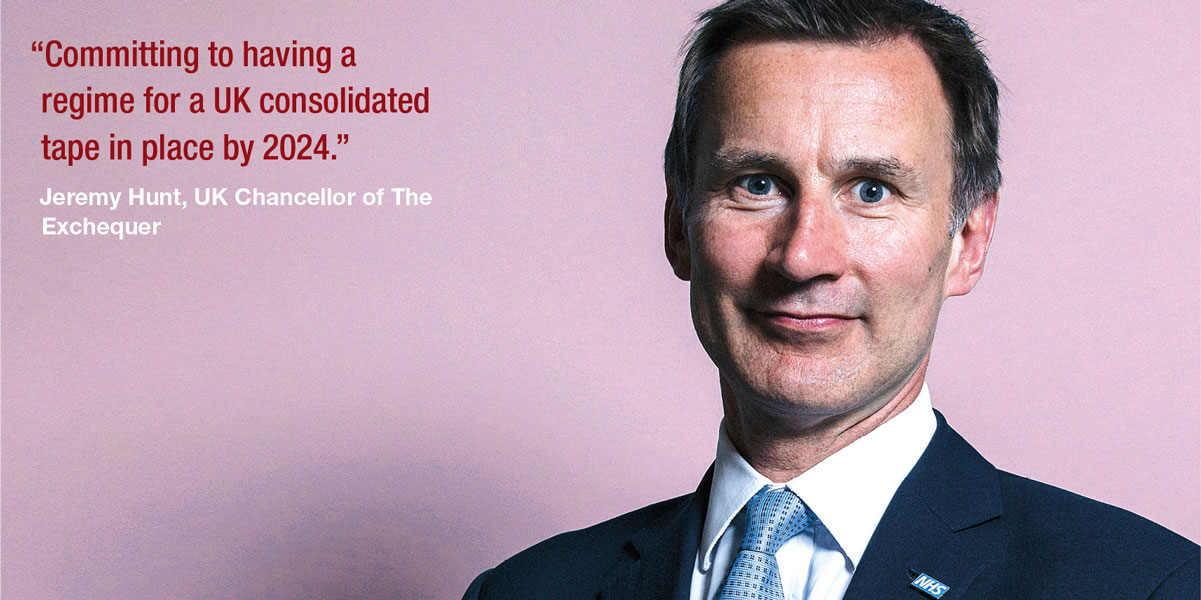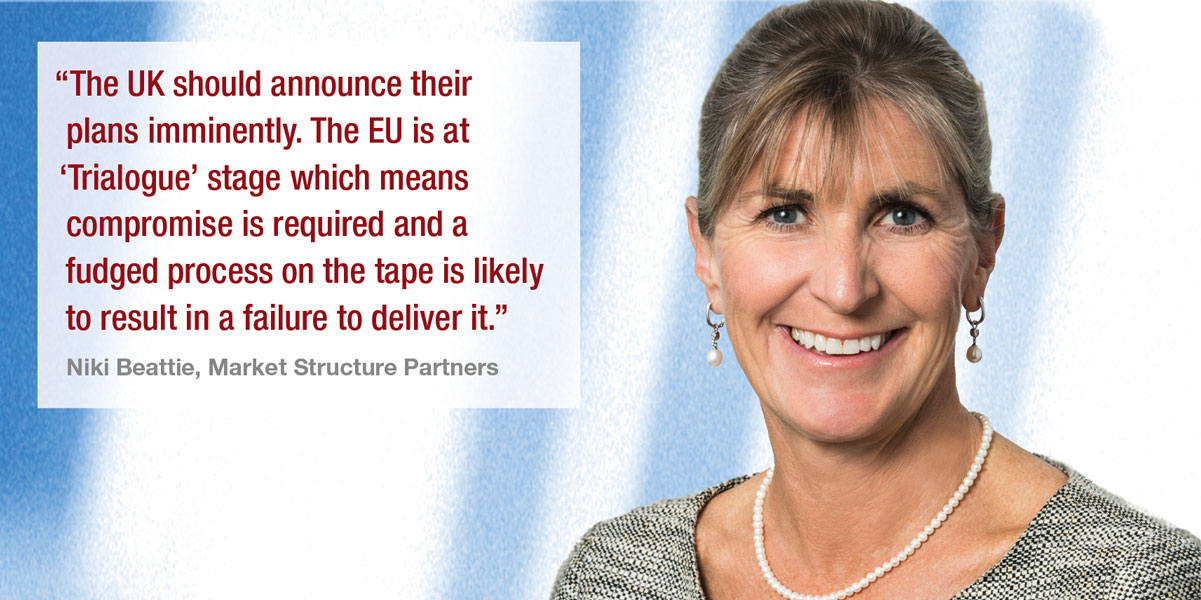Having spotted the need for a consolidated tape in 2005 – when the US already had one – Europe and the UK are so close, but so far, from achieving this goal. Dan Barnes reports.
In 2005, the Europe Commission (EC) did not want its nations’ capital markets to be silos of activity, and so it proposed rules to increase competition between them and to electronify securities trading. Manifested as MiFID in 2007, later revised in 2018 (MiFID 2), they also fragmented market structure and trading. Investors who had relied on national exchange data feeds to know how much of a security was traded and at what price lost their bearings.
“One issue is about trying to reconsolidate the data from various venues to get a full picture of what has happened,” said Simon Thompson, then head of equity portfolio trading at Barclays Global Investors, speaking to the author in 2005. “The second issue is created around assessing the validity and integrity of that data.”
Seventeen years later, Europe may be in the last mile of its journey to consolidate, clean and validate post-trade data, for equities and other asset classes.
European Union plans are in place, and firms are rolling out potential technological solutions. Then on 9 December 2022, Jeremy Hunt, the UK Chancellor of The Exchequer, said the government was “Committing to having a regime for a UK consolidated tape in place by 2024.”
“The timing is difficult to judge,” says Stephane Malrait, head of market structure and innovation, financial markets at investment bank ING. “They started to prepare themselves two years ago but it hasn’t happened in the intervening period. It seems that the time is getting closer than ever. The Czechs [who hold the EC presidency] are really trying to make a deal by the end of the year. If they don’t make the deal by the end of the year, then probably a deal will happen in January or February, once the Swedish take the presidency.
I don’t think we’re six months away, we probably are a couple of weeks away to start the trialogue process on the European side. And we also have more certainty from the UK side as well, following the announcement last week by the UK Government as part of the Edinburgh reform announcement, so there will be a CTP in the UK.”
Niki Beattie, CEO of consultancy Market Structure Partners, says, “The UK should announce their plans imminently. The EU is at ‘Trialogue’ stage which means compromise is required and a fudged process on the tape is likely to result in a failure to deliver it. It might be easier in fixed income as there are less people opposing a tape and its starting from further behind.”
Getting over the line
At an operational and technological level, things have also improved in recent years, with several technology firms developing tools to manage the issues first raised by Thompson in 2005, in the fixed income space.
“For the last two years, since the proposal from the EC to create a tape was published, there is a lot more interest in it from the buy side and sell side,” says Malrait. “We have noticed that data quality has also improved, since people started to refocus on it, even the data which is available today.”
Firms such as Ediphy, Finbourne and Propellant.digital, have engaged in making the existing data sets usable to ensure a viable tape can emerge. The three firms are also – reportedly – being scouted by a consortium of major trading venues who are partnering to develop a tape.
“They are all connected to data already available from approved publication arrangements (APAs) and trading venues, and have created software to aggregate this data, similar software that a CTP could use,” says Malrait. “And because of that people can now look at the data, make sense of it and that has renewed interest to confirm that an official CTP will make sense.”
Chris Murphy, CEO of Ediphy says, “The blockers for the bond tape are relatively few and far between; the biggest blocker is actually there not being agreements on the equity tape because until they can solve both the equity tape and the fixed income tape, they’re not going to pass the regulation.”
There is discussion regarding the inclusion of sovereign bonds on the tape. The US has had a bond tape, TRACE, since 2006 but only included its government bonds in 2017 and then not publicly. This reflects the regulatory reluctance to engage with government debt, which is an instrument of policy, as well as strong sell-side dominance of these markets.
“There is some debate on the bond tape around whether and in what shape, sovereigns will be included. So there is a line of thinking, certainly in the Commission and elsewhere, that because this is all about Capital Markets Union (CMU), and CMU is about encouraging capital formation, and financing companies within the EU, then it’s all about corporate bonds and equities, while sovereign bonds are somewhat of an afterthought. But we and other market participants are saying the sovereign bond market forms the basis of the risk free rate as everything else is built upon that and it would be somewhat perverse, although we’ve had this on TRACE for some time, to have far more liquidity on high yield bonds than on government bonds.”
In the equity space there is more of a challenge on the political side from incumbent exchanges who make the most from selling data and have the largest market share.
“They are the ones that don’t want a tape,” says Beattie “Now we are being presented with half cooked solutions from politicians as they try to mitigate the exchanges’ concerns. The latest one is to have a pre-trade snapshot of the best bid offer (BBO) alongside the post-trade tape, but not a real time pre trade tape. This is not an ideal solution and, if we end up with this, it will be an ‘emperor’s-got-no-clothes-on’ moment, as the consolidated tape provided (CTP) would have to collect the pre-trade data real time and despite being technically able to disseminate it real time there would be a regulatory gate that would stop it from doing so.”
Murphy says, “Our latest intel on the equity tape is that there is still a lot of pushback from smaller exchanges on pre trade data. The argument is always about a loss of revenue. There’s been talk around a one-minute delayed pre trade tape alongside a post-trade tape, potentially with an opt out for some of those smaller venues, or even a snapshot of consolidated top of book quotes at the time of each trade.”
The price tape of failure Appetite for progress is keen and growing, says Malrait, and at a technical level firms are already very keen to exploit the access to data being created ahead of the tape’s launch.
“Definitely the interest is there,” he says. “It’s just the timing, which is an issue. Is pressure increasing? I think yes. Increasingly as people can access the data, and ING is part of that, we start to use the public data available to analyse the market structure, which bonds are not traded, for pricing algorithms and back testing, because we start to see that the quality is there. That will change when it goes live with a CTP because also the deferral regime will be different than it is today. But even with the data that we have today, we start to see this value.”
Murphy adds, “I think the shape of the current deferral framework is fairly well set. That being said, we’re going to get a lot more real time transparency and the deferral regime will be vastly simplified. The current quarterly, instrument by instrument thresholds for SSTI and LIS, etc, that’s going to be done away with. The regime is going to be simplified, such that there will be five different categories based around amounts outstanding, and that will dictate liquidity thresholds. Obviously, a large benchmark issue has much more liquidity than less, which toggles liquid/illiquid type. There is also a different deferral window, depending on the size of the trade.”
Beattie observes that sticking points still include the UK finalising its thinking on whether there should be a single tape or multiple competitive tapes, with the bias currently towards competition.
“I think this is a big mistake because no one has fixed the governance issue – a well-run tape needs some teeth to be able to set and enforce standards and determine the price at which consolidated data should be sold,” she notes. “I don’t believe that this can be done by multiple organisations.”
However, even in the EU, where they are advocating a single tape, she says they have still missed the point about governance.
“Everything being discussed is about a technology firm running the tape but all along we have said this is not a technology problem, it’s a governance one and the CTP organisation needs to be empowered to fix the quality of data,” she asserts. “This may be less of an issue in fixed income markets where any set of data is probably better than the non-existent data today. Obviously, the other important point is we still don’t have agreement on the inclusion of pre trade data in equities. The people who actually use the data want pre-trade data and the tape will only really become viable if pre trade data is included.”
The costs and the potential for failure is a grave concern still, Beattie believes.
“It’s very high on both fronts and so the risk is that nothing will emerge in equities in the EU and in the UK which is a massive disappointment for the end investor,” she warns. “Anyone opposing the tape cannot justifiably say that it is bad for the end investor. They are simply protecting their own pockets. For fixed income I think more potential solutions will emerge.”
[This article was first published in our sister publication, Best Execution]
©Markets Media Europe 2025













